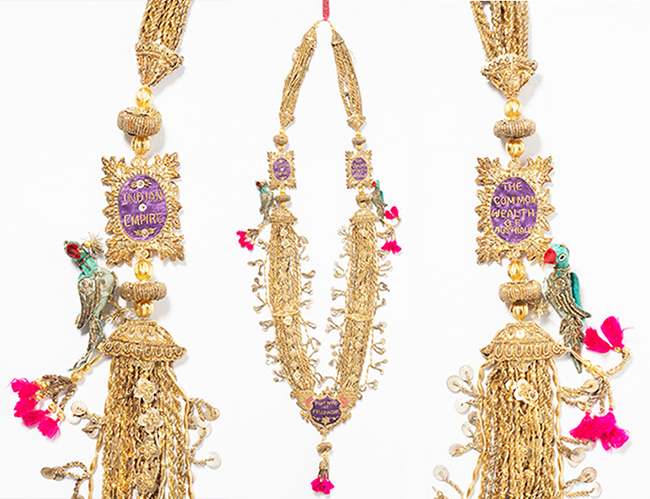Registered with the Registrar of Newspapers for India under R.N.I 53640/91
Vol. XXXIII No. 24, April 1-15, 2024
Madras-lace garlands presented to the Duke and Duchess of York and the Prime Minister of Australia in Canberra in 1927
-- by A. Raman, anant@raman.id.au
The Sydney Morning Herald (SMH, Syndey, Australia) of 11 May 1927 features a news item entitled the Decorative collar (lace garland) presented to the visiting British royalty and the then Prime Minister Stanley Melbourne Bruce on 9 May 1927 during the opening of Provisional Parliament House in Canberra. The news item further says that it was presented by Diwan Bahadur T. Rangachariar, Representative of the City of Madras in the Legislative Assembly and former Deputy-President of the Indian Central Assembly of the British Indian Government. After the official opening, those representatives from diverse segments of the British Empire spoke. During Rangachariar’s turn, he — from Madras — presented the lace garlands to Duke of York Albert George and Duchess of York Elizabeth Bowes-Lyon, and to Prime Minister Stanley Bruce. The SMH also mentions that Rangachariar read a Sanskrit poem, composed by him, entitled India’s message to Australia. The poem offered formal greetings and reiterated the bonds formed between Australia and British India during the First World War.

Lace garlands presented by the Indian representative T. Rangachariar, to dignitaries on the occasion of the inauguration of the Provisional Parliament House in Canberra in 1927 – (on display at the Parliament of Australia: Icons and Collections).
The two ornate, silk pads on either side of the lace garlands featured embroidered lace work expressing British India’s friendship and the bonds of the Empire. On the one side it included ‘the Indian Empire’ and on the other ‘the Commonwealth of Australia’. The garlands were made from silver sequins, glass beads, padded silks and tassels, and embroidery with twisted and tightly coiled, springy lace material.
The SMH report clarifies that news reports of this event made by other news agencies liberally exaggerated describing the garlands as being woven of solid gold and studded with beautiful jewels. The SMH issue of 11 May 1927 clarifies that none of that was correct.
For a biographical note on T. Rangachariar, who practised as a lawyer in Madras, please see the webpage http://www.vengrai.com/?p=56 by Vengrai Parthasarathy. I take the liberty of paraphrasing a brief section from Parthasarathy’s write-up. His (Rangachariar’s) brilliant parliamentary performance, his erudition and services brought their own recognition. He was honoured with the titles Rao Bahadur, Dewan Bahadur. For his conspicuous ability as Deputy–President, the British government honoured him with the title Companion of the Indian Empire (CIE) in 1925. This was followed by his nomination as the Representative of India at the Inauguration of the Australian Parliament and declaration of Canberra as the new Capital of Australia. While in Australia, Rangachariar in his ethnic outfit stood out. The SMH’s story titled ‘Picturesque Indian Representative’, read “The semi-circular benches around the throne in the Senate are rapidly filling up. The Indian representative Dewan Bahadur T. Rangachariar is in picturesque turban and his caste mark in red on his forehead. His native costume contrasts with his modern tortoise-shell spectacles”.
Appendix. Tamil film actor and producer K(rishnamchari) Balaje (1934-2009) of yesteryears was T. Rangachariar’s grandson, born as the third child to R(angachari) Krishnamachariar and Janaki Devi. Balaje used to live in a house on Pantheon Road, which bore the name Canberra for many years. If my memory serves right, this property is now occupied by the Egmore branch of the Indian Overseas Bank. Readers can make the connexion why the house occupied by Balaje in the late 1950s-early 1960s was named Canberra: it celebrates Rangachariar’s visit to Canberra!
Note on Dewan Bahadur T Rangachariar

The accompanying photograph appeared in The Pictorial History of South India for 1928 and the caption below it reads – Dewan Bahadur T. Rangachariar CIE, ex-Deputy President of the Indian Legislative Assembly who proceeded to Australia as India’s representative.
Rangachariar lived in Ritherdon House on the eponymous road but he owned Veda Vilas on Egmore High Road and it is known that he built the house on Pantheon Road, which he named Canberra after his Australia visit. Veda Vilas was very well known in Carnatic Music circles for it was the residence of Rangachariar’s son Tiruvenkatachari aka Muthanna who together with the vainika R. Rangaramanuja Iyengar ran the Jagannatha Bhakta Sabha from the premises (see MM, Vol. XXVII, No 18, Jan 1-15, 2018). It was a formidable venue that all Carnatic music performers aspired to get a concert invite from. Many of the greats in the world of Carnatic music of the era spanning 1920 to 1950 made their reputation there.
Prior to becoming the home of Rangachariar, Veda Vilas was the residence of the scholar K. Venkata Lakshmana Rao and this was where the social reformer Kandukuri Veeresalingam Pantulu breathed his last in 1919.
As for Ritherdon House, it had an even older history, stretching back to colonial times, well covered in the back issues of Madras Musings (see Vol XXIII, No 8, August 1-15, 2013) and elsewhere.
– Deputy Editor

